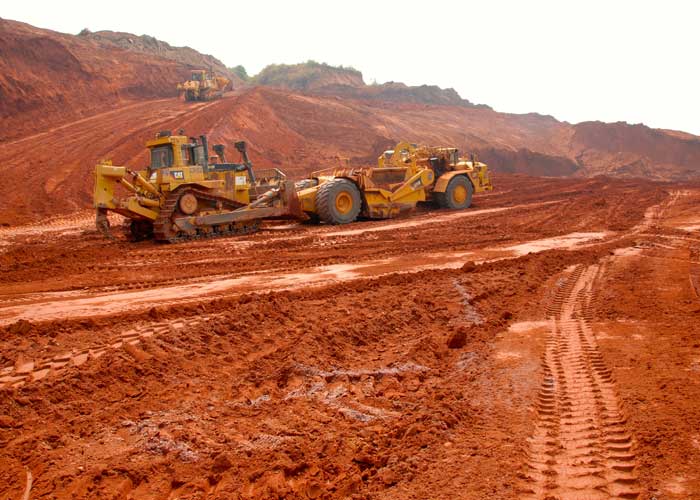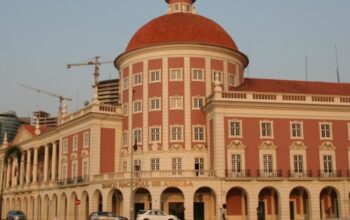In line with the mining operations in the provinces of Lundas Norte and Sul, we were able to witness the complexity of all the engineering work, developed with alluvial diamond deposits in mind, which became more valued from 2018 onwards, with the implementation of a new commercialization model, which eliminated the so-called “preferred customers”. The first stop was at N’zaji, municipality of Cambulo, base of operations of SMC (Sociedade Mineira do Chitotolo), since 1986, with the research and exploration of several mines, first as an Association in Participation. With a concession area of 5,400 square meters, it is now the largest employer in the region, with a workforce of 910 workers, 87 percent of whom are nationals. Traveling from the city of Dundo, where we had flown directly from Luanda the day before and under high temperatures at this time of year, as in the entire territory of Lunda-Norte, we found in N’zaji a typical mine environment, with a total frenzy of machines all around the perimeter, especially in the vast hydrographic area of the Luembe River. Narciso Agostinho’s lens registered an unstoppable movement of light and heavy excavators, heavy bulldozers, dump trucks, articulated trucks, loaders, motor graders, motoscrapers, powerful probes and other technical means, in numbers that impress those who arrive for the first time. once to a mine. Some still new and others more than eight years old, there are a total of 120 pieces of equipment and all of them are part of the vast gear for the search for diamonds in the Nzaji region. The framework, created with the new policy of commercialization of Angolan diamonds, has brought advantages that allow, today, the managers of Chitotolo to face the future with more optimism, after a vigorous investment in state-of-the-art equipment, as an example of a sophisticated Choice Center. The new unit, to be set up in Chitotolo, replaces the current one, which, built 69 years ago, has been in marked structural degradation for some time, although it is still in operation. It was explained to journalists that the acquisition of the new equipment represents a total investment of 6.5 million dollars and is in line with the ambition of Sociedade Mineira do Chitotolo to treat large volumes of concentrate. However, a source from this diamond company, which has a strong presence in the N’zaji region, covering sectors such as health, education, environment and others, would confirm in Luanda that this figure could reach eight million dollars, which clearly translates , the size of the enterprise. technology bet The same source provided data on the trend of financial movement in 2019 and 2020, as well as investments for this year. Two years ago, sales reached $122 million, while the following year they dropped to $91.86 million. From January to April, net income has already reached US$35.28 million, which may indicate a good financial position, when the results for May and June are still to be accounted for. But there are other relevant facts, which were shared with journalists. In 2019, US$20.49 million was invested, with 85 percent going to earth-moving equipment and heavy vehicles, such as hydraulic excavators, crawler tractors, front loaders, dump trucks, cisterns and workshop. Light and mixed vehicles, generators, prefabricated units and other equipment consumed the other part of SMC’s investment. Last year, investments totaling US$18.91 million were made, 93 percent of which were used for the new Chitotolo Choice Center. For this year, investments were estimated at $8.7 million, with earth-moving equipment taking almost 70 percent of the share. The rest goes to metallurgical means, light and heavy vehicles, generators, pump systems and pumps for exploration, civil construction and video surveillance systems. Engineer Alexandre Albuquerque, operations director of Sociedade Mineira do Chitotolo, was our main guide while we remained in the N’zaji area. It was from him that we learned that this mining company, which is on its way to turning 25, is the largest alluvial diamond exploration project ever undertaken in Angola. Regarding the acquisition of the new diamond sorting unit, he has no doubt about the added value it brings to the company, after years of some retraction in investments in technical means, firstly due to the sudden drop in the price of diamonds on the international market and, then, with the previous commercialization policy, which had little transparent outlines, significantly affecting the sector. “This is the last acquisition that we are making, in terms of metallurgical treatment, that is, the purchase of a new unit for the final concentration of diamonds”, explained Alexandre Albuquerque, referring that at this time they are being transported, some from Luanda and others from South Africa, all the equipment, for assembly in the new plant. On site, the work is being done in detail, with hundreds of people involved in the various works. This is a large-scale logistical operation, which, as we could see in the village of Nzaji, already has an impressive concentration of hundreds of containers, machines and other equipment, with which the aim is to quickly complete the project. “Here is a big technological difference, the complexity of the operations forces us to acquire much more up-to-date equipment, which allows the treatment of a greater amount of material”, underlined the miner, who has more than 30 years of experience. It’s a race against time. SMC managers want to see the new unit in operation later this year. “We expect to complete its assembly by August or September”, said the operations director, insisting on the gains with the new policy for the commercialization of Angolan diamonds. “The implementation of the new commercialization policy, as of 2018, has brought gains that have allowed us to revitalize our activity, with the purchase of more and better equipment and, above all, the sequential projection, which we are currently carrying out”, he said. Project resilience Engineer Alexandre Albuquerque revealed that the drop in the price of diamonds and the Covid-19 pandemic led to the rapid closure of some mining areas, such as Sangulungo and Camule, all in Chitotolo, to advance to others that allowed results. desirable, given the critical moment we were experiencing. “Between 2016 and 2018, we had gravel mining in the ratio zone between Maluita, so that we could obtain the necessary revenue for the normal development of SMC”, he said. He added that this strategy involved a rapid increase in the level of gravel treatment, exploration and, also, the implementation of several mining units. Alexandre Albuquerque referred to “very difficult times”, in a scenario in which, at times, revenues were almost insufficient to maintain the continuity of the project, with the Management Board focusing on maintaining workers’ salaries, something that was achieved, even at the expense of desirable investments. After that period, the focus is now on mixing explorations in various sites, where substantial investments were implemented, as a result of the new diamond marketing policy, which allows for a greater financial outlay, as the director of mining operations at SMC clarified. He indicated that from 2011 to 2017 that the company’s income had been decreasing, consecutively, with reflexes to the investment capacity, registering a change, from the following year, with the price of the carat going from 323 dollars to 570, bringing high earnings. Contingency plan against Covid-19 Alexandre Albuquerque proved to be “safe” about the evolution of operations, even in times of crisis, aggravated by Covid-19. “The evolution continues to be positive”, he stressed to journalists, before explaining, in detail, the “Contingency Plan” adopted, so that the impact of the pandemic was not so brutal on mining operations. During the most acute phase of the pandemic crisis, the mine’s workforce was reduced to just 38 percent, with SMC’s Board of Management moving forward with measures to protect the company’s continuity. “We got to have only 38 percent of the total working mass, precisely because of the inability to find accommodation in the camps, as most of them live in areas outside Njazi”, said Alexandre Albuquerque, highlighting the capacity for resilience. It was, in fact, a period lived with unusual uncertainty at the Chitotolo mine, as, indeed, in the whole world, but which seems to be starting to be part of history, believing in the optimism stamped on the face of Alexandre Albuquerque, since, as he indicated, “with time, the necessary infrastructures for the maintenance of mining operations were activated”. At this point, around 60 to 63 percent of the workers are already relocated in the Chitotolo and Maludi camps, which represented a considerable logistical effort. Now, work is being carried out at a frenetic pace to expand accommodation capacity, so that, by August, it will reach at least 75 percent, in what is seen as the beginning of the path towards the full resumption of mining operations. Close to achieving the return of all workers to the mines, SMC begins the path to return to production levels prior to the onset of the pandemic crisis. Data made available to journalists at N’zaji indicate that in 2019, 247,759 carats were produced and the following year, 172,746. For 2021, projections point to 224,155 carats, a slight increase, reflecting greater activity in mine, with the return of more workers, as is said elsewhere in this piece. At Chitototolo, compliance with preventive measures against Covid-19 is taken to the extreme. Conditions for the use of masks, distancing, frequent hand washing and respiratory etiquette were reinforced. The expatriates spend 10 days in Luanda, before accessing the mine and with a negative test, while the nationals encamped undergo seven days of medical observation, before leaving for work. Social investment for communities As we have seen, Sociedade Mineira do Chitotolo is already a consolidated process of integration with the various communities that live within the concession. It would seem that a lot revolves around it. There is direct support for education, of which the construction of schools in N’zaji and Maludi, to receive 440 and 250 students, respectively, is illustrative. Since 2019, a school complex with eight classrooms for 450 children and young people, a medical post and two houses for teachers and health technicians has been built for the communities of Much and its surroundings. The infrastructures were shown to journalists and should be delivered, fully equipped, later this year, according to information at the site of the director of mining operations. SMC invests, monthly, as a contribution to salary payments in the municipality of Cambulo, the equivalent of about 1.5 million dollars, while close to 5,000 family members of workers and 350 retirees, with their respective spouses, are guaranteed medical and medication assistance. . A detail: Recently, part of the construction material of these infrastructures was looted, a serious setback for the contractor, but which was comforted by the company, which is going to expand the investment in sealing the facilities. It is something that was not foreseen in the initial budget, of more than 1,500 thousand dollars, but that confirms SMC’s growing social responsibility. Including the construction of three schools and a computer lab, in the last three years the investments made in the social area amounted to around 4,000,000 dollars, as guaranteed by a source from the society. In the same vein, municipal and communal authorities, traditional and social entities, have also benefited from diverse support from this mining society. The director of mining operations made it clear that it is now intended to change the paradigm, saying that “from the moment we verified that the normal conditions for the commercialization of diamonds were restored, we opened more and we are in contact with the Government of Lunda-Norte and with the Cambulo Administration, for the reorganization of our social action”. He explained that this involves establishing a tripartite program between the Government, Caritas and Chitotolo, so that “instead of just supporting the construction of schools, we start to involve the whole community, which will have a say in the education for children and the construction of medical posts in each of the villages”. This is the “Educar Project”, whose details the Jornal de Angola will bring soon. reforestation process Alexandre Albuquerque showed us a vast plantation of trees, reflecting the growing concern with restoring environmental conditions in mining areas. He said that the project, for which a company was subcontracted, was also seriously affected by the circumstances of the Covid-19 pandemic. “We have a company that is providing services to us in this area, but which is currently on stand by. We hope that it will return, so that in all the areas where we are exploring the environmental conditions will be restored and, over time, we will see how At this point, we can look for the side effects that occurred in previous times”, he added. “We cannot forget that there have been areas of diamond exploration for about 100 years”, said the director of operations, as if anticipating possible criticism about environmental sustainability, with the removal of large amounts of land in mining areas. Semicolon in this passage through Chitotolo. Before leaving the village of N’zaji, at nightfall, we were taken to see the society’s health center, on a “surgical visit”. It is well equipped and the vaccination campaign against Covid -19 is a priority among workers. and their dependents. The following day would be a long journey of over eight hours, from Dundo to the well-known village of Cafunfu, passing through Lôvua, Cuilo and Caungula. There is the Cuango Project, which passed to Sociedade Mineira do Cuango, a partnership between Endiama, ITM and Lumanhe, which holds, in Lunda-Norte, a concession of 3,000 kilometers in the area of the Cuango River, which will be our next stop in this incursion into diamond exploration projects in the Lundas region.
![]()




